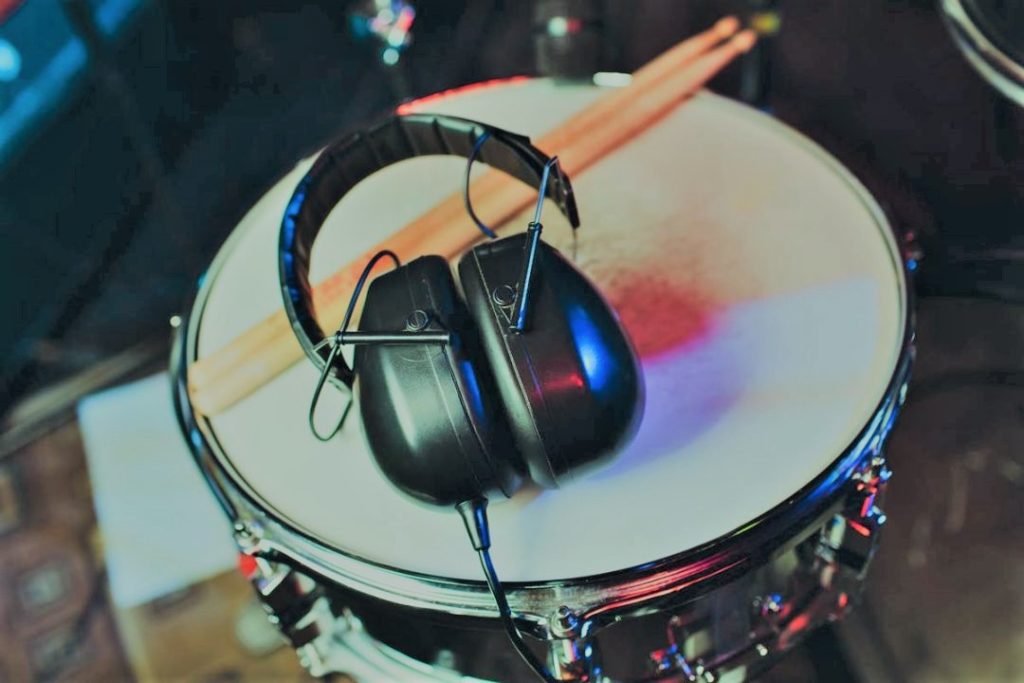Looking for the best headphones for drummers? Headphones became an important part of our daily lives over the last few decades. We use them all the time to improve the overall experience while we play video games, watch movies and TV shows or listen to our favorite music playlist or podcast.
Musicians also use them to listen to the rest of the band during live shows, studio performances, and practice sessions.
With the insane number of headphones on the market, it’s difficult to filter your options and remain confident that you’re making the best decision as a drummer.
Additionally, whether you usually rock some corded over-ear headphones or wireless in-ears, the truth is, most consumer-grade options aren’t what you would call ideal for drummers. Why?
Tinnitus and hearing loss are among the biggest dangers working drummers face daily, as drums are way too loud.
That means that while playing, you need some high-quality sounding headphones, and at the same time, headphones that protect your hearing by reducing a good amount of external noise.
A few brands, especially the ones directly involved in the music industry, manufacture isolation headphones specifically designed for drummers, and musicians in general.
To summarize, the best headphones for drummers are the best noise-isolating headphones with good enough sound quality.
Before deciding which are the best headphones, we need to discuss the most important features, such as, sound quality, comfort, weight, cable length, and of course, noise reduction levels.
Now let’s talk for a second about each feature individually:
- Sound quality: if you’re buying headphones as a drummer, they have a bigger impact on your performances than you might think. They need to provide a clear and balanced sound so you can properly hear the rest of the band and do your job well.
- Comfort: since gigs and practice sessions can go for hours, comfort is one of the most important factors when it comes to headphones. The two options drummers use the most are in-ear monitors and over-ear headphones. It’s all a matter of personal preference so you won’t know what you find more comfortable until you try both. This article focuses on headphones exclusively.
- Weight: let’s be honest, no one wants to play with 10 pounds on top of their heads. It’s especially important when it comes to over-ear headphones because you want them to be as light as possible, without jeopardizing the overall build quality and durability of the headphones.
- Cable length: this doesn’t sound that important, but it is. Having a short headphone cable is the most annoying thing in the world. You need to measure the distance between where you sit, and where your laptop, phone, or mixer usually is, and buy accordingly. Thankfully, if everything else fails, headphone extension cords exist to make our life a little bit better.
- Noise reduction levels: as a drummer, you can’t step away from the noise, making this the most important feature to look for in headphones. Noise reduction helps in two different ways: it lowers the volume of your kit and at the same time, since your kit volume is lower, the volume of the music you’re listening to is automatically lower too. Look for headphones that reduce at least 20dB of external noise.
Now that we know why drummers need a good pair of headphones, and what to look for when you’re on the market, here are the best headphones for drummers:
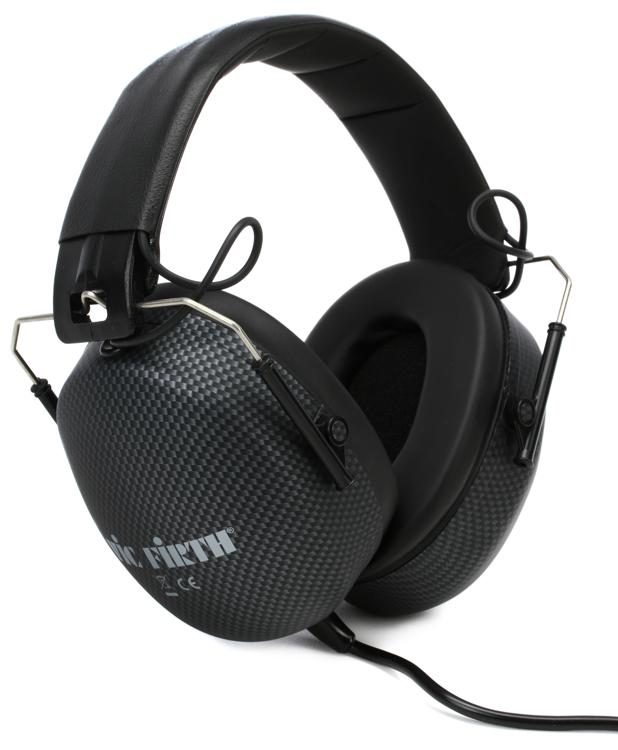 Specifications:
Specifications:
- Noise Reduction: 25dB
- Cable Length: 5.5’
- Driver Size: 50mm
- Frequency Response: 20Hz – 20kHz
- Impedance: 29,35 ohms
The Vic Firth Stereo Isolation Headphones V2 were designed for drummers, but they are suited for all musicians.
They have a frequency response of 20Hz to 20kHz and a noise reduction of around 25dB.
In terms of noise reduction, even though it’s listed as 25dB, which is on par or below some of the alternatives, I honestly feel they do a better job at reducing the noise around you than most headphone in this article.
The format of the headphones and how they sit in your head might have something to do with that.
Sound quality improved a lot, especially when compared to the first version, with cleaner highs, fuller mids, and bigger bass. They are still not considered Hi-Fi, since their main focus is noise reduction and not the best sound quality.
As an owner of a pair of Vic Firth SIH2s myself, I must say that they are comfortable enough, but not the best for longer periods.
That’s even more obvious if you wear glasses as they apply significant pressure to the side of your head and after a while, it starts to hurt.
Overall, this a solid choice for someone on a budget, as the Vic Firth SIH2s aren’t the best at anything but do everything well enough to justify their affordable price.
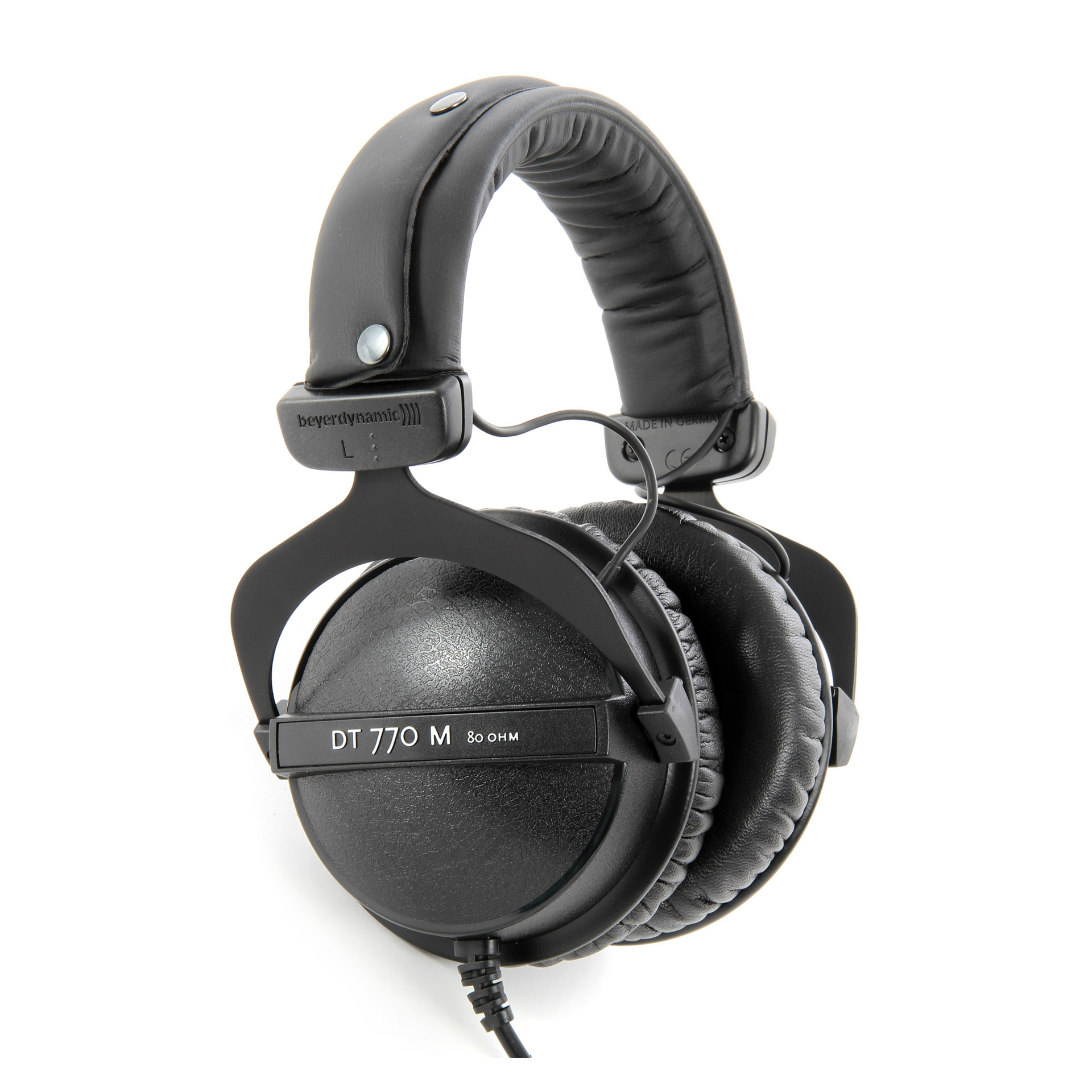 Specifications:
Specifications:
- Noise Reduction: 35 dB
- Cable Length: 9.84’
- Driver Size: 45mm
- Frequency Response: 5Hz – 30kHz
- Impedance: 80 ohms
If Vic Firth’s main focus is noise reduction, Beyerdynamic’s on the other hand is comfort paired with sound quality.
Marketed as studio headphones, the M version of the famous DT 770 series was designed with drummers in mind. It’s pretty much the same as the Pro version, but with an additional 15dB of noise reduction.
The sound is much better than Vic Firth’s and the soft ear pads allow you to wear them for as long as you want without feeling any discomfort.
In other words, they offer a very accurate, crisp, and clear sound while also providing a very comfortable fit and reducing a decent portion of the external noise along the way.
The DT 770 M is versatile enough for you to wear while practicing, performing live or at the studio, or simply watching movies at home.
Considering every single part is replaceable, this is an easily serviceable pair of headphones, which makes them a great long-term investment.
The biggest downside is the price as they can cost two or three times as much as the cheap alternatives we have on this list.
If you’re playing an acoustic kit, buying the M version of the DT 770 is the right thing to do. Otherwise, if you’re playing on an electronic drum kit or plan to use them mostly on stage where you don’t need as much noise reduction, the Beyerdynamic DT-770 Pro is just as good with a similar price.
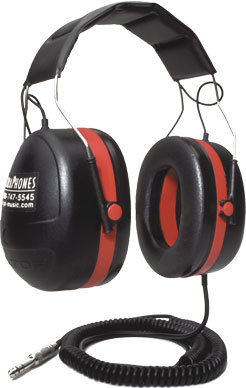 Specifications:
Specifications:
- Noise Reduction: 29 dB
- Cable Length: 9.8’
- Driver Size: 40mm
- Frequency Response: 10 Hz – 20 kHz
- Impedance: 63 Ohm
Gordy Knudtson founded GK Music in 1995 to help many musicians that just like him, suffer from tinnitus or hearing loss.
GK Music manufactures the Ultraphones that protect every musician’s hearing from loud external noises but also reduces the need for obnoxious and harmful volume levels. They are designed by a drummer, for drummers.
Speaking of drummers, Mike Mangini and Mike Portnoy (current and ex-Dream Theater’s drummer) were my first contact with the Ultraphones.
My initial thought was that “they look like regular earmuffs with an audio cable”, and I wasn’t that far.
The foundation of the Ultraphones is the industry-standard Sony MDR-7506, used by many professionals all over the world from different backgrounds.
Despite the high-quality sound, they are not that great when it comes to noise reduction as their main focus is a well-balanced and clear sound.
That’s why the Sony MDR-7506 foundation paired with some passive isolation earmuffs responsible for reducing up to 29dB, makes them the best headphones for drummers.
They cost twice as much as the DT-770 M and four times as much as the Vic Firth SIH2, which makes the price the only downside of the Ultraphones.
With that in mind, should you put a price tag on your health and safety? As a long-time tinnitus sufferer, I don’t think so. Ultraphones are the best headphones for drummers, period.
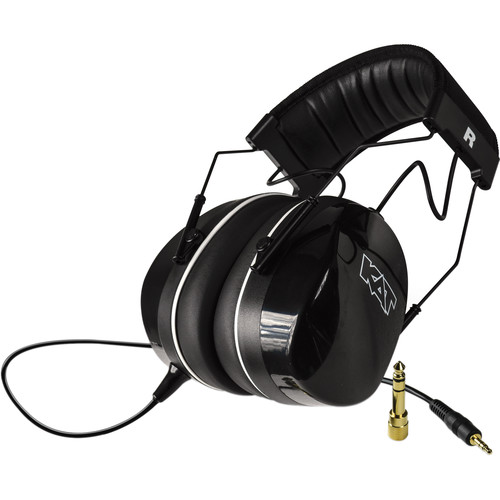 Specifications:
Specifications:
- Noise Reduction: 26dB
- Cable Length: 6′
- Driver Size: 40mm
- Frequency Response: 20Hz – 20kHz
- Impedance: 32 Ohms
Kat Percussion was one of the first electronic percussion companies, and they’re mostly known for their electronic drum kits.
The KTUI26 is the newest addition to their catalog, and it’s a smart one.
If most of their sales are electronic drum kits, it only makes sense to manufacture and sell headphones designed for drummers.
The KTUI26 in particular is a pair of over-ear headphones with a 20Hz to 20kHz frequency response and a passive noise reduction of 26dB.
The fact that they are lightweight (10.8 oz) and feature large foam ear cushions makes them comfortable enough through short sessions.
Similar to the GK Music Ultraphones and the Vic Firth SIH2, they resemble regular protection earmuffs and are specially designed with drummers in mind.
Just like the SIH2, the sound quality isn’t the greatest but definitely enough to work with if you aren’t an audiophile like myself.
Another similarity is how uncomfortable they are if you play for longer periods, even more so if you wear glasses.
The KTUI26 share more with the Vic Firth SIH2 than a couple of negative aspects: the price.
That makes them a good option for drummers on a budget if sound quality isn’t your main priority and you don’t plan to play long sessions regularly.
 Specifications:
Specifications:
- Noise Reduction: 29dB (36.7dB at 8kHz)
- Cable Length: 8’
- Driver Size: 40mm
- Frequency Response: 20Hz – 20kHz
- Impedance: 32 Ohms
Direct Sound might not be as well known as the rest on the list, but they are amazing at what they do: building isolation headphones for professional audio enthusiasts and musicians in general.
The new EX29 Plus is a great option for drummers who want it all: sound quality, comfort, and good isolation.
Sound-wise, they’re considered crisp and clear enough for any musician to use at the studio and even the audio engineer when it’s time to mix the tracks.
Their comfortable ear cushions and 29dB noise reduction keep click bleed out of your tracks and painfully loud noise out of your ears.
That makes them one of the most versatile pair of headphones on the list, as you can use them for hours and hours, in either pro or personal audio devices.
Although they claim to reduce 4dB more than the Vic Firth SIH2, my experience of owning both tells me that’s a bit misleading. The truth is, SIH2 does a better job at reducing outside noise, while the EX29 Plus provides a much better sound quality.
One unique, but interesting, small feature is the bright red fabric on top of the rear panel of the right channel that identifies the right and left (just remember, red is right).
Unlike the alternatives on the list, it has a 9’ detachable audio cable. That gives you the ability to change the cable length, or the cable itself if it stops working somehow.
There isn’t a single situation where the Direct Sound EX29 Plus won’t rock, and their average price is more than adequate for the type of headphones you get.
Now, the biggest downside:
They are made with low-quality plastic and some users claim their model broke in a few months.
With a good sound quality, impressive comfort level, and decent noise reduction, the build quality is where the EX29 Plus lacks the most.
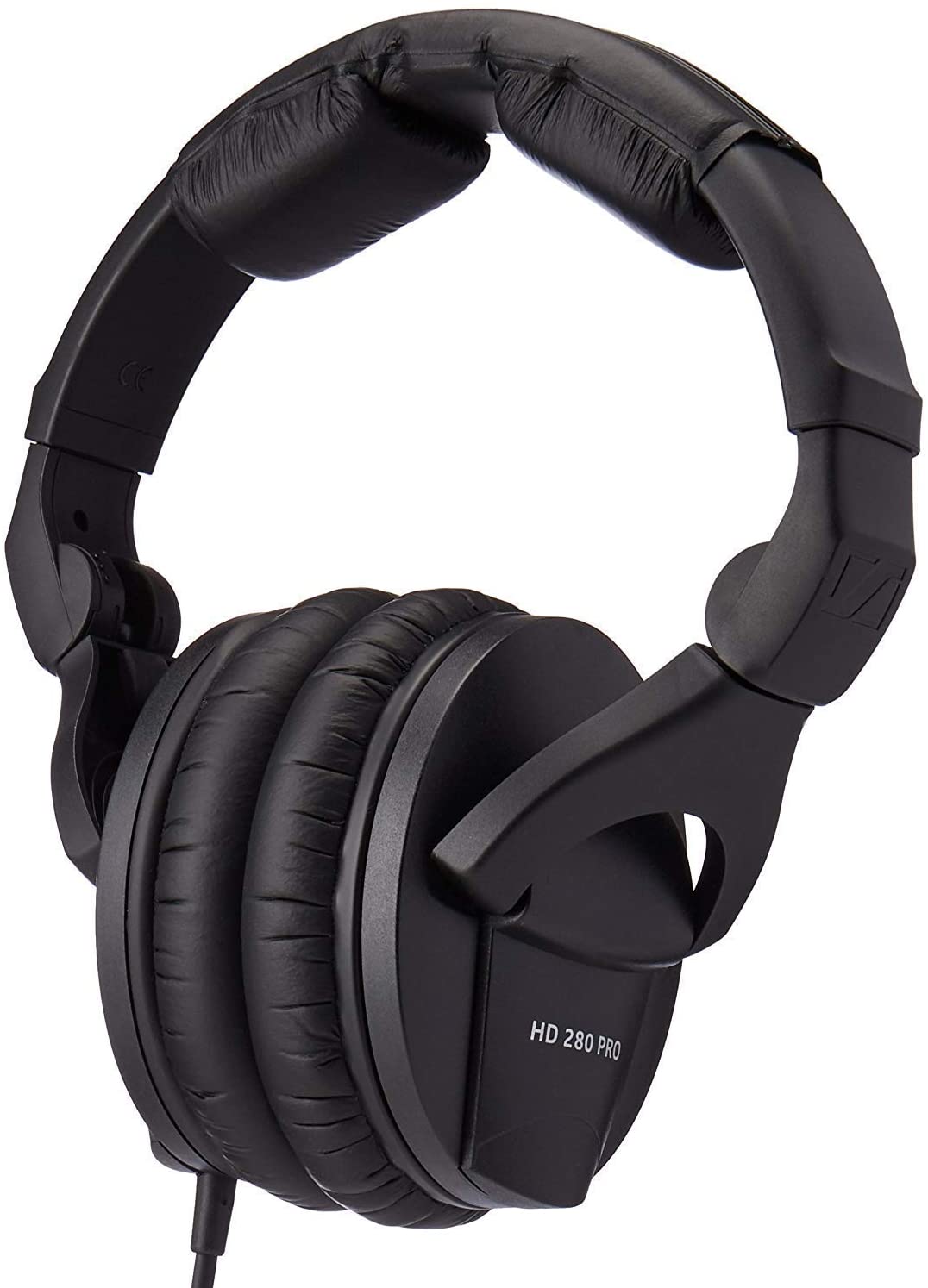 Specifications:
Specifications:
- Noise Reduction: 32dB
- Cable Length: 9.8′
- Driver Size: Not Applicable
- Frequency Response: 8Hz – 25kHz
- Impedance: 64 Ohms
Sennheiser is a German audio company specialized in the design and production of Hi-Fi products such as aviation headsets, telephone accessories, and drum gear, like microphones and headphones.
Sennheiser HD280 Pros provide an accurate and linear sound reproduction with “eloquent lows, a distinct midrange, and clear-cut highs”. That makes them great for both recording and mixing sessions.
In terms of isolation, they offer a 32dB noise reduction that allows you to clearly hear your headphone monitoring mix no matter how loud the sessions get. They also keep your monitor mix from bleeding into your microphones, a really important feature for any studio musician.
The HD280 Pros are comfortable which means all the hours spent in front of your drum kit or pc screen won’t tire your ears as much (the podcast “The Joe Rogan Experience” is a good example of how good they are during long sessions).
Folding and rotating earcups make them relatively portable and the earpads may retain some warmth, which is a good or a bad thing, depending on the weather.
The Sennheiser HD 280 Pro feels sturdy and won’t get damaged by a few drops. With that in mind, the ear cup joints are the weakest point of this pair of headphones and most likely what will break eventually.
With a price of around $100, it’s simply one of the best bang-for-the-buck headphones currently available that serves many purposes.
Hear me out…
I’ve owned four of the headphones recommended in this article, and currently own two of them. I’ve played with them all in many different settings, and they are honestly the best headphones for drummers.
What you buy depends on what you value the most: is noise reduction or sound quality more important? Are you on a budget or price doesn’t matter? Are you only satisfied with the best of the best?
If you value noise reduction and you’re only satisfied with the best of the best, the GK Music Ultraphones specially designed for drummers make any practice session sound like a fully mixed drum kit.
You’re on a budget but you still value noise reduction the most? A lot of professional and amateur musicians do just fine with either the Vic Firth SIH2 or the KAT Percussion KTUI26. They might not have the best sound quality, but they sound good enough, and most importantly, they reduce a lot of the external noise.
Sound quality is king and you’re looking for something to play drums with as well as watch some movies? The Beyerdynamic DT 770 M and the Sennheiser HD280 Pro are two of my favorites and the the brands are reliable enough to give you some peace of mind for years and years.
The Direct Sound EX29 Plus is balanced in terms of sound quality, comfort, and noise reduction but their mediocre build quality makes it hard for me to recommend them over any of the other five.
They are still one of the best headphones for drummers, just make sure to take good care of them if you decide to buy them anyway.

